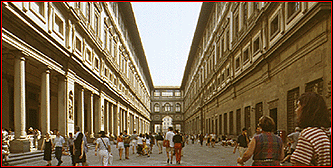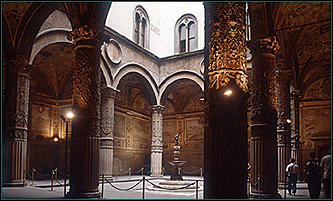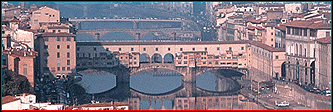Giorgio Vasari
1511-74
LIFE
Overview
Giorgio Vasari was a successful Florentine Mannerist painter and architect whose greatest contribution to the history of art and architecture is a book of biographies of Renaissance artists and architects called Lives of the Most Eminent Italian Architects, Painters, and Sculptors (Vite de' più eccellenti architetti, pittori e scultori italiani).
Today, Vasari's architecture is admired far more than his paintings, but in his own time, he was highly regarded as a painter.
Places Where Vasari Worked
Vasari was born in Arezzo in 1511. In 1524 he was apprenticed to the High Renaissance painter Andrea del Sarto, who worked in Florence.
He worked in many places including Rome, his native Arezzo, and Florence, where he received many commissions as both a painter and an architect for Duke Cosimo I de' Medici.
Establishing the Accademia del Disegno
Vasari was one of the founders of the Accademia del Disegno in Florence, which was established in 1563 to set standards and improve the status of artists. Types of art were ranked in a hierarchy in which history paintings were at the top and still-life was at the bottom. In 1572, the academy was given the status of a guild. (In later centuries, art academies tended to institutionalize art traditions, which led to the concept of "Academic art." By the 19th century, the rebellion of young artists against academic standards erupted with such movements as Impressionism.)
Collecting Drawings by Other Artists
In the course of doing research for his book, Vasari traveled around Italy and became acquainted with a number of living artists and architects. This enabled him to acquire a collection of artists' drawings, which he published in two volumes as the Libro de' disegni.
Vasari was ahead of his time in his appreciation of drawings both as independent works of art and as sources of evidence of the artist's intentions during the preparatory phase of an art work's design.
Valuing drawings was a natural consequence of Vasari's being a proponent for the superiority of Florentine painting, which was based on line, over Venetian painting, which was based on color.
Acquaintance with Michelangelo
Vasari's acquaintance with Michelangelo enabled him to be a pipeline for conveying the aging master's ideas concerning architectural projects in Florence to Ammannati, Cosimo I's main architect. Vasari sent Ammannati a clay model by Michelangelo for the vestibule stairs of the Laurentian Library, which Michelangelo had worked on in the 1520s and early 1530s. It is also possible that Michelangelo designed the elliptically curved arches of Ammannati's Ponte Santa Trinita.
VASARI'S LIVES
Overview
Vasari's Lives of the Most Eminent Painters, Sculptors, and Architects combines biographical and critical material about Italian Renaissance artists and architects. His original 1550 edition was greatly expanded in the 1568 edition. It includes information about materials and techniques and expresses the author's view of artistic progress.
Importance
This book is the first systematic account of art history, and its importance to the study of Italian art cannot be overestimated. Despite its many factual errors, Vasari's Lives is still the best single source of information, and in the case of some artists and architects, it is the only source of information on their lives and the art and architecture they produced. Vasari's Lives is invaluable not just for its information about artists and architects but also for the light it sheds on attitudes toward art in the mid-sixteenth century.
Sources
To gather information for this monumental undertaking, which was conceived in 1543, Vasari corresponded with many individuals and traveled around Italy. Because many of the subjects lived long before Vasari's time, the biographies include much information that was anecdotal or based on local myths.
Vasari's View of Art and Artistic Progress
Vasari considered Art to be the imitation of Nature (the physical world) and judged its historical evolution accordingly. He viewed the Renaissance as a period during which artists again acquired the ability to depict the physical world, a skill that had been learned during antiquity but lost during the Middle Ages.
Vasari's division of the stages of this progression according to centuries is still the most commonly used system for classifying Italian Renaissance art. Accordingly, he saw the fourteenth century as a period of redefining the goals and working out basics of form and color, the fifteenth century as a period of technical experimentation with perspective, anatomy, and media, and the sixteenth century as a period of mastery attained by Leonardo, Raphael, and especially Michelangelo, whom he called divine.
PAINTING CAREER
Productivity
Vasari, who was proud of the speed with which he and his assistants worked, painted a great many frescoes.
Rome
In 1546, Alessandro Farnese commissioned Vasari to paint a large reception room in the Palazzo della Cancelleria, an important ecclesiastical palace in Rome. The painting's theme is the glorification of Alessandro's grandfather Pope Paul III. The room is called the Sala dei Cento Giorni (Room of a Hundred Days) for the brief time it took to paint it.
For Pope Pius V, Vasari painted the walls of the Sala Regia in the Vatican from 1572-73.
Florence
In Florence, Vasari painted images of the Medici family and Florence's history in several rooms of the Palazzo Vecchio, which had been made into Cosimo's personal residence. These included the Salone dei Cinquecento, the Room of Lorenzo the Magnificent, the Room of Pope Leo X, and the Room of Pope Clement VII.
Many of Vasari's wall and ceiling paintings follow the manner of the painted decoration of the Domus Aurea, which had been popularized by Raphael and Peruzzi in Rome. Much of the decorative work Vasari did for the Medici is replete with references to the family such as the Capricorn emblem, the astrological symbol of Grand Duke Cosimo de' Medici.
ARCHITECTURAL CAREER
Overview
Although most of his work was in Florence, Vasari also worked as an architect in Rome, Pisa, Cortona, and his hometown of Arezzo, where he maintained a residence.
Collaboration with Ammannati
Vasari worked both alone and in collaboration with others, especially Ammannati. His most important work is the façade of the Uffizi, an office building that is now a major museum specializing in Italian art.
Work in Arezzo
In Arezzo, Vasari designed Santi Fiora and Lucilla and the Logge Vasariane.
Remodeling Churches
Vasari remodeled the interiors of Santa Croce and Santa Maria Novella according to the Council of Trent's recommendations, which were aimed at enhancing the worshipper's ability to see and hear the services.
ARCHITECTURAL WORKS
♦Villa Giulia (administrative role), Rome, 1550-55. Vasari's role at the Villa Giulia was primarily administrative, and its design was the work of two other architects. Vignola designed the main building, whose façade is divisible into three distinct parts. The three central bays project forward as a single, highly plastic unit. Beyond the entrance vestibule is a semicircular loggia that forms a rounded end to a large courtyard. Ammannati designed the other end, which leads to the nymphaeum. A ground-level loggia overlooks the sunken nymphaeum.
♦Great Grotto (lower story of facade), Palazzo Pitti, Florence, 1556. Cosimo commissioned Vasari to design the Great Grotto in 1556, but because he died before its completion, only the ground story reflects his original design. The ground story is similar to that of the Uffizi Palace in having a three-bay colonnade and niches containing sculpture.
♦Palazzo degli Uffizi, Florence, begun 1560. Cosimo I de' Medici centralized the administration of the government by concentrating all its agencies, which were scattered about Florence, at the Palazzo degli Uffizi. It is located off the Piazza della Signoria next to the Loggia dei Lanzi and the Palazzo Vecchio. The Uffizi's U shape is made up of two long parallel wings connected by a short wing that is open all the way through on the ground story. The long horizontal lines are countered by the articulation of the façade into three-bay sections that are center emphatic. The end wing incorporates the Palladian motif on two stories. The building's conversion to a museum began in the 1580s when Francesco de' Medici commissioned Bernardo Buontalenti to begin remodeling the top story. In 1737, the Medici family collection of Italian art, which is one of the finest in the world, was given to the state on condition that it remain in Florence.
♦
♦Palazzo Vecchio (remodeling and decoration), Florence, 1555-72. In 1565, Vasari decorated the courtyard of the Palazzo Vecchio (then the Palazzo Ducale and residence of Cosimo I) in preparation for the arrival of Cosimo's son Francesco and his bride, Joanna of Austria, who were to be the new residents. He painted the walls with scenes of Austrian towns, which were intended to provide the bride with visual reminiscences of her homeland. Vasari ornamented the columns with gilded stucco relief and painted the vaulting with conventional decorative designs of arabesques and grotesques, which had been inspired by paintings in the Domus Aurea.
♦Vasari Corridor, Florence, 1565-66. The enclosed passageway that Vasari built for Duke Cosimo I de' Medici is now known as the Vasari Corridor (Corridoio Vasariano). It connects the Palazzo Vecchio, the seat of Florentine government, and the Palazzo Pitti, to which Cosimo moved in 1550.



 Add Placemark
Add Placemark Go Back
Go Back 







